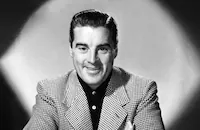Flight at Midnight
Brief Synopsis
Cast & Crew
Sidney Salkow
Phil Regan
Jean Parker
Col. Roscoe Turner
Robert Armstrong
Noah Beery Jr.
Film Details
Technical Specs

Synopsis
Pop Hussey, the manager of Norwalk Airport, which is the headquarters of speed king Colonel Roscoe Turner and his lion cub "Gilmore," must raise $100,000 to bury the high tension wires surrounding the field or else he will lose his license for passenger traffic. Pop's troubles are compounded when Spinner Magee, his daredevil airmail pilot, is late for a delivery and, after pushing his plane to the breaking point, endangers his and his mechanic Torpy's life when he glides to a landing. The next day, flight inspector Jim Brennan grounds Spinner for thirty days because of his dangerous stunt. Spinner thinks that Jim's action is because Spinner dated his girl friend, stewardess Maxine, and so he starts a fight with Jim. Pop breaks it up and pleads with Spinner to be less reckless and self-centered, but to no avail. To spite Pop and Jim, Spinner and Torpy begin a flight school, which interferes with the airport's normal routines. Maxine sufficiently distracts Spinner one afternoon to allow the scheduled departures and landings to occur on time, and then tries to convince Spinner to be more cooperative. Spinner refuses to abide by Jim's rules, but agrees to help Pop by testing designer Hank Neary's new plane, which, once it is certified and goes into production, will bring in the money Pop still needs. Spinner's arrogance asserts itself again, however, and he fails to show up for the test. Torpy bravely takes his place and is killed in a fiery crash. Spinner is crushed by the accident and hardly notices when Turner, hoping to get Mayor John Harper's support to force the city to dispose of the wires, agrees to fly a group of mayors to the county fair. On the approach to the field, however, Turner's plane loses an engine, and he tries to glide the plane over the tension wires. Spinner hears the commotion and takes off in his plane. With daring heroism, Spinner flies into the wires and breaks them just in time to allow Turner to land. The injured Spinner convalesces in the hospital, and after his friends tell him that the wires have been fixed, he is reunited with Maxine.

Director
Sidney Salkow
Cast

Phil Regan

Jean Parker
Col. Roscoe Turner

Robert Armstrong
Noah Beery Jr.
Harlan Briggs
Helen Lynd

Barbara Pepper
Harry Hayden
Raymond Bailey
Crew
Cy Feuer
Phil Ford
Ralph Freed
Eliot Gibbons
Hugh King
Burton Lane
Howard Lydecker
John Victor Mackay
Ernest Miller
Daniel Moore
William Morgan
Adele Palmer
Armand Schaefer
Murray Seldeen
Al Wilson

Film Details
Technical Specs

Quotes
Trivia
Notes
According to a Hollywood Reporter news item, the title was changed to Midnight Flight during production. It was changed back to Flight at Midnight before release. Another pre-release title was Flight Inspector. According to Hollywood Reporter and Daily Variety news items, Bernard Vorhaus was briefly slated to produce and direct the film with a script by Grace Neville. John H. Auer then was assigned to produce and direct but was taken off the film to concentrate on another picture for Republic. Los Angeles Times noted that Ruby Keeler was considered for a part. This was Phil Regan's seventh and final film for Republic. Roscoe Turner was a well-known pilot in the 1930s. He broke many speed records, including seven transcontinental records, and flew with his lion cub "Gilmore" until Gilmore outgrew the cockpit. Turner retired from competition in 1939, and according to the film's copyright material, this was "his first starring film, although he has worked in the making of many air films."












